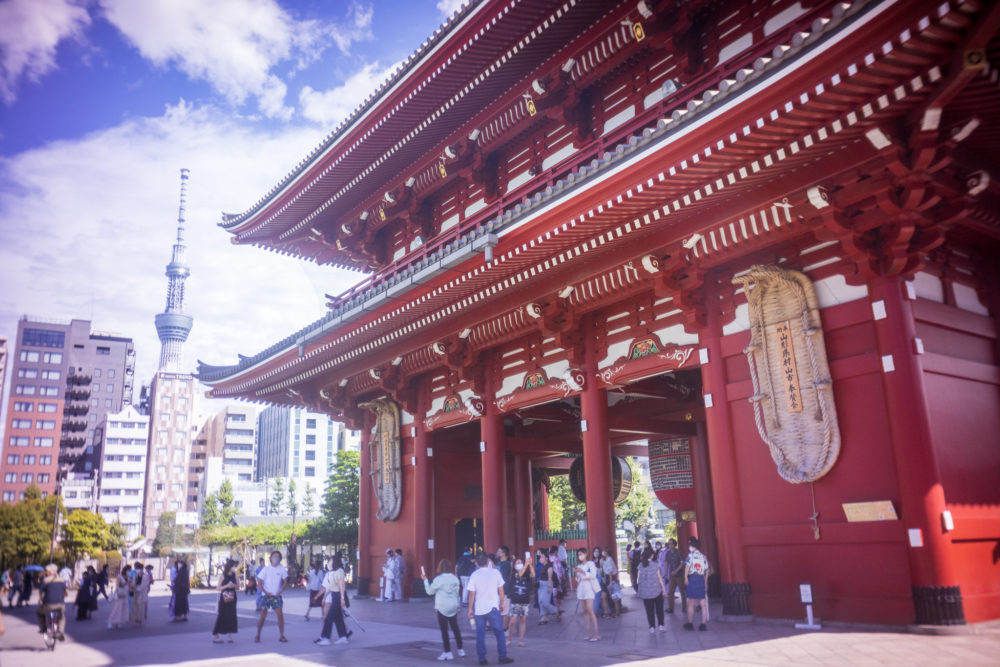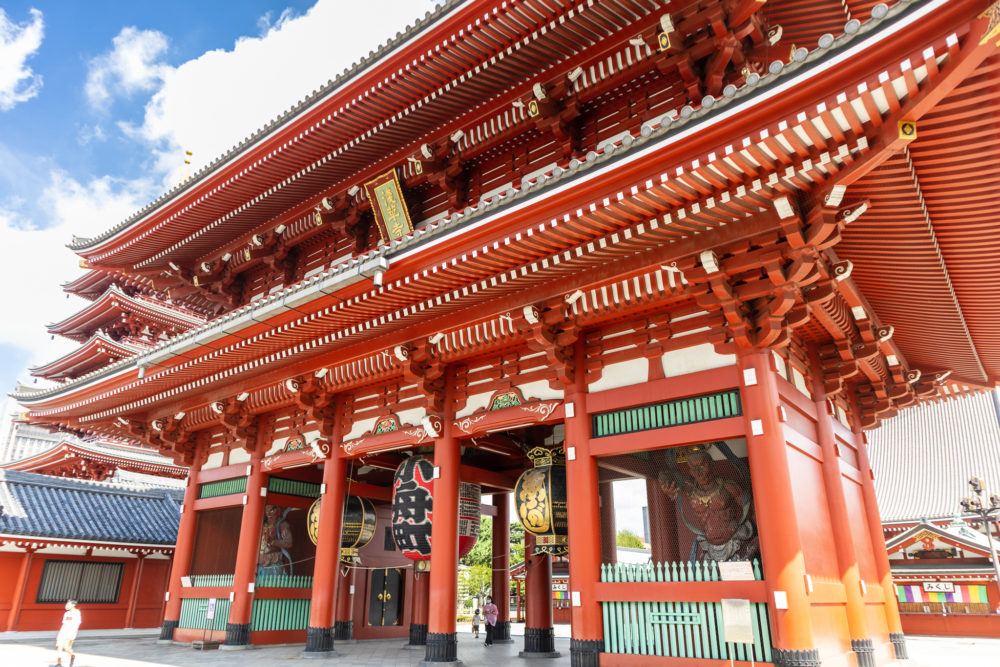Tokyo Shitamachi Guide’s “Highlights” category covers must-visit spots in Tokyo’s Shitamachi area (the area along and east of the Sumida River). We select an interesting spot each time for your sightseeing in Tokyo.
This time, our recommended spot is Hozomon Gate at Sensoji Temple in Taito Ward.
Hozomon Gate is a gigantic two-story gate in front of the main hall of Sensoji Gate. On the second floor of this gate, the temple keeps Buddhist sutras known as “Genban Issai Kyo,” important national cultural properties.
When tracing the history of the sutras, you will come across Hojo Masako. She was the lawful wife of Minamoto no Yoritomo, the founder of the Kamakura Shogunate in the 10th century. You might be surprised to learn that such a historical figure is related to Sensoji Temple.
This blog post will share information about Hozomon Gate at Sensoji Temple. Please use it as a reference when you visit Tokyo’s Shitamachi area, especially the Asakusa area, for sightseeing.
We hope this blog post will help you somewhat when you visit Tokyo for sightseeing. If you have any questions, feel free to contact us through the contact form.
This blog post is also available in Japanese. You can refer to it at the following link:
History
According to Sensoji Temple, the history of Hozomon Gate dates back to the 10th century. And its history is related to a military commander who played an active role in the Taira no Masakado Rebellion.
In 935, the Taira no Masakado Rebellion broke out. Taira no Masakado, a local ruling family in the Kanto region, rebelled against the central government in Kyoto. He tried to establish an independent nation by occupying most of the Kanto region.
In 940, the central government in Kyoto suppressed the rebellion. And Taira no Kimimasa was one of the military commanders who contributed to the suppression. He was a cousin of Taira no Masakado.
In the same year, Taira no Kimimasa was appointed the chief governor of the Awa-no-Kuni Province for his contributions. The Awa-no-Kuni Province is the southern part of present-day Chiba Prefecture.
But Taira no Kimimasa was not happy with it. He wanted to become the chief governor of the Musashi-no-Kuni Providence, which is present-day Tokyo, Saitama Prefecture, and part of Kanagawa Prefecture.
In 941, Taira no Kimimasa prayed for his promotion at Sensoji Temple. In 942, he successfully became the chief governor of the Musashi-no-Kuni Providence. So he thanked Sensoji Temple very much.
At that time, Sensoji Temple was in ruins due to the Taira no Masakado Rebellion. Taira no Kmimasa devoted his efforts to rebuilding the temple.
In 942, Taira no Kimimasa built Hozomon Gate. This gate, at that time, was called Niomon Gate because a pair of Nio statues, the guardian gods of Buddhism, were enshrined at this gate.
Hozomon Gate has been burned down and rebuilt repeatedly. The last damage was caused by the Bombing of Tokyo in 1945. This air raid burned not only Sensoji Temple but also a large part of Tokyo.
In 1964, Hozomon Gate was rebuilt into its current building. At the same time, Sensoji Temple changed the name of this gate from Niomon Gate to Hozomon Gate.
Highlights
Genban Issai Kyo
On the second floor of Hozomon Gate, Sensoji Temple keeps Buddhist sutras known as “Genban Issai Kyo,” important national cultural properties.
Tsurugaoka Hachimangu Shrine was the original owner of “Genban Issai Kyo”. Tsurugaoka Hachimangu Shrine is an old Shinto shrine located in Kamakura, Kanagawa Prefecture.
Hojo Masako dedicated “Genban Issai Kyo” to Tsurugaoka Hachimangu Shrine. She ordered the Buddhist sutras from China to hold a memorial service for her eldest son, Minamoto no Yoriie.
Hojo Masako was the lawful wife of Minamoto no Yoritomo, the founder of the Kamakura Shogunate in the 10th century. And Minamoto no Yoriie was the Kamakura Shogunate’s second Shogun.
In 1868, the Meiji government issued the Shinbutsu Bunri policy. This policy clearly distinguishes between Shintoism and Buddhism, Shinto deities and Buddhist deities, and Shinto shrines and Buddhist temples.
This policy resulted in the abolition of Buddhism, known as Haibutsu Kishaku. Haibutsu Kishaku is an attempt to remove the influence of Buddhism from Shinto shrines.
Tsurugaoka Hachimangu Shrine was about to dispose of “Genban Issai Kyo” due to the abolition of Buddhism. In 1871, Teiunni, a Sensoji Temple nun, bought the sutras.
She wanted to keep the sutras at Sensoji Temple. But the sutras consist of 5458 scrolls. Shinmon Tasugoro helped her bring the sutras from Tsurugaoka Hachimangu Shrine to Sensoji Temple.
Shinmon Tatsugoro was the fire chief in Asakusa. He was also famous for building Hikan Inari Shrine in the precincts of Asakusa Shrine.
For more details about Hikan Inari Shrine and Asakusa Shrine, please refer to the following blog posts:
Buddhist Deities
Sensoji Temple enshrines two Nio statues at Hozomon Gate. Nio is a pair of Buddhist guardian gods, also known as Kongo Rikishi.
A statue on the left side of the gate is called Agyo. He has an angry expression with an open mouth. A statue on the right side of the gate is called Ungyo. He has an angry expression with a closed mouth. Both are very heavily muscled gods.
According to Sensoji Temple, the following Buddhist deities are enshrined on the second floor of Hozomon Gate. They are not open to the public, either.
- The Buddha (Siddhartha Gautama)
- Jikokuten
- Zojoten
- Komokuten
- Tamonten
- Fujin (the wind god)
- Raijin (the thunder god)
A Gigantic Paper Lantern

Another highlight of Hozomon Gate is the gigantic paper lantern hanging in the center of the gate. This lantern says “Kobunecho” which indicates Nihonbashi-Kobunecho in Chuo Ward, Tokyo.
The history of this lantern dates back to 1659. Fish market workers in Nihonbashi-Kobinecho first dedicated a gigantic lantern to Sensoji Temple. They wanted to show their prosperity and strong faith.
According to Sensoji Temple, Hozomon’s gigantic lantern has been replaced four times in the past. The most recent replacement was in 2014.
Gigantic Straw Sandals

Behind Hozomon Gate, giant straw sandals are dedicated for Nio to wear. These sandals have the meaning that “those who wear such gigantic sandals protect Sensoji Temple” to ward off evil.
Matsuoka Toshizo first donated the straw sandals to Sensoji Temple in 1941. He was a politician from Murayama City, Yamagata. Since then, new straw sandals have been dedicated to Hozomon Gate every 10 years.
There are three main reasons why Matsuoka Toshizo dedicated gigantic straw sandals to Sensoji Temple.
- He was a follower of Sensoji Temple.
- He wanted to commemorate the enactment of his bill for relief from snow damage.
- He wanted to pray for victory in the Second Sino-Japanese War.
FYI, the Second Sino-Japanese War was a war fought between Japan and China from 1937 to 1945.
Murayama City has dedicated large straw sandals to Sensoji Temple for generations. Once the straw sandals have finished their role, they will be returned to Murayama City and burned.








